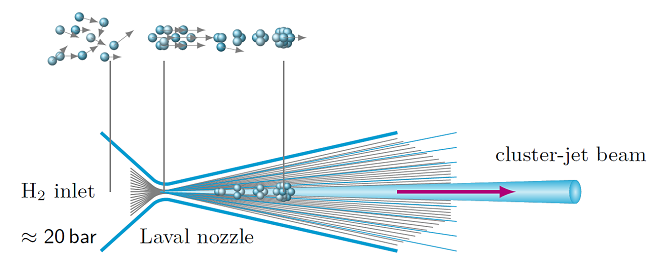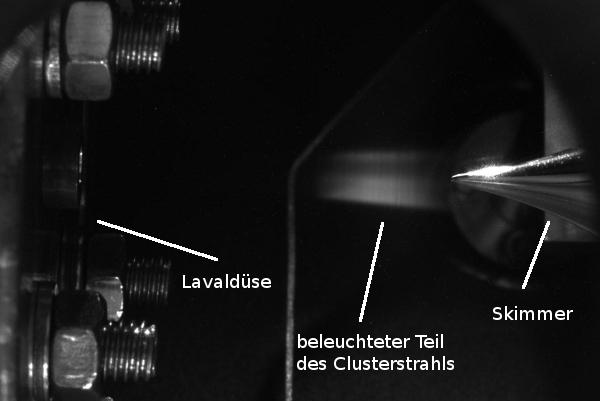The cluster-jet target
For experiments with accelerated beams in storage rings internal targets are needed which provide a target thickness of 1014 to 1015 atoms/cm2. Cluster jets are a smart way to generate such targets.
Clusters are structures formed from atoms or molecules. In case of hydrogen, which is commonly used for these cluster jets, the molecules are bound by van-der-Waals forces. In these cluster-jet targets the hydrogen gas at pressures of about 18 bar is cooled down to temperatures of 20 to 30 K and pressed through a Laval nozzle. The chosen temperature, pressure and nozzle geometry is optimized for the production of the clusters. Since only a small fraction of the used gas forms clusters, an orifice, called skimmer, is used to separate the cluster jet from the surrounding gas. The final shape of the cluster jet is defined by a second orifice, the collimator.

The Münster type cluster-jet targets can be divided into three main parts. The first part is the cluster source, where the nozzle, the skimmer, and the collimator are situated. The scattering chamber represents the later interaction region with the accelerator beam. In this region the target thickness of 1014 to 1015 atoms/cm2 has to be provided. The third part is the beam dump, where the cluster jet is stopped and pumped away. The beam dump has to be constructed in such a way, that as few gas molecules as possible are reflected back into the scattering chamber.
The bachelor, master and PhD students which work at the Münster type cluster-jet target not only construct and build these targets but furthermore work on the ongoing improvement of the complete system. For this, they optimize the setup, the vacuum system, and the cluster jet properties. Furthermore they develop methods used for the precise determination of the properties of the clusters and the cluster jet.
This precise determination of the cluster jet properties, especially the target thickness, is very important for the use in internal storage ring experiments. For the measurement of the target thickness, important quantities like the jet diameter and the cluster velocity are measured. In order to determine the cluster velocity, single clusters are ionized by a pulsed electron gun and detected at the end of the beam dump. Since the distance between the electron gun and the detector is known, the velocity of the clusters can be calculated from the measured time-of-flight.

